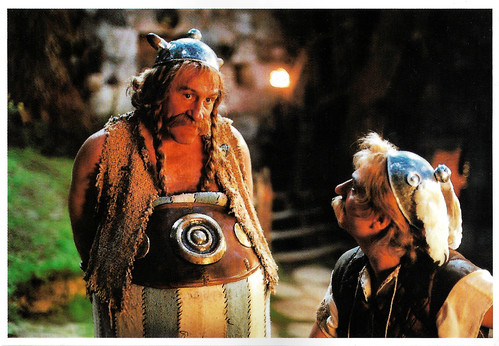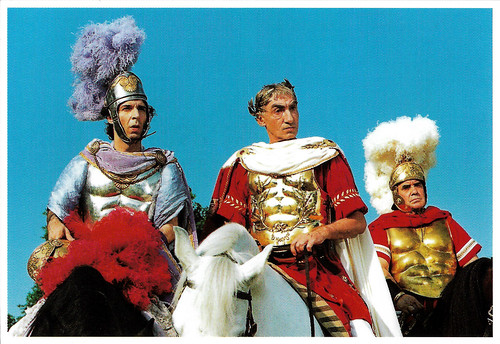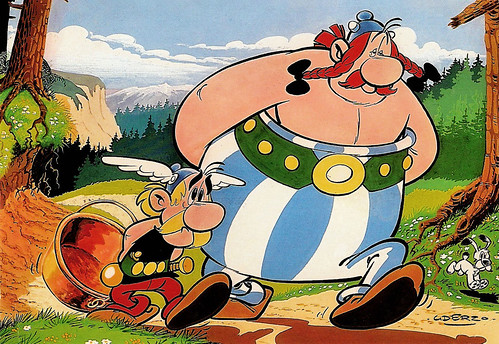
Big Happy New Year card by Pathé. Photo: Christian Clavier and Gérard Depardieu in Astérix & Obélix contre César/Asterix and Obelix Take on Caesar (Claude Zidi, 1999).

French postcard by Pathé. Photo: Katharina / Renn Productions / TF 1 Films / Bavaria / Melampo. Christian Clavier in Astérix & Obélix contre César / Asterix & Obelix Take on Caesar (Claude Zidi, 1999).

French postcard by Sonis, no. C 944. Photo: Etienne George / Renn Productions. Laetitia Casta in Asterix & Astérix et Obélix contre César/Asterix & Obelix Take On Caesar (Claude Zidi, 1999).
The one little Gaulish village that has not surrendered to the Roman occupation
In 1927, the French comic book artist and scriptwriter Albert Uderzo was born in the town of Fismes, in the Marne department of north-eastern France. In the 1930s, Albert developed a fascination for American comic and animated cartoons and was particularly impressed with the works of Walt Disney.
He was a poor student at school but received good grades in sketching and art-related lessons. By the 1950s, Albert Uderzo had become a professional artist, and he met his partner René Goscinny in 1951.
During the 1950s, Uderzo provided the artwork for moderately successful series such as the historical fiction series 'Oumpah-pah' and 'Jehan Pistolet' (both written by Goscinny) and the aviation comic series 'Tanguy et Laverdure' (written by Jean-Michel Charlier).
'Asterix' debuted in October 1959 in the French magazine Pilote, created by René Goscinny and Uderzo. In 1961, the first stand-alone effort, 'Astérix le Gaulois' (Asterix the Gaul), was released. It was turned into an animation film, Astérix le Gaulois/Asterix the Gaul (Ray Goossens, 1965).
The comic book series centres around the titular Asterix, the bravest warrior in a small town in the middle of Roman-occupied Gaul in the year 50 B.C. — and the one burg that has not surrendered to the occupation. Instead, with the help of a magic potion that gives him super-strength (and his best friend Obélix, who fell into a cauldron of the potion as a child, and as such is permanently superhumanly strong), he spends each instalment fighting and defeating the Roman army and keeping his village safe from harm.

French postcard by McCann Communications, Nanterre, offered by Agfa. Photo: Etienne George / Renn Productions. Michel Galabru and Daniel Prevost in Astérix & Obélix contre César / Asterix & Obelix Take on Caesar (Claude Zidi, 1999).

Small French postcard by AGFA / McCann Communications, Nanterre / Renn Productions. Photo: Etienne George. Christian Clavier and Gérard Depardieu in Astérix & Obélix contre César/Asterix and Obelix Take on Caesar (Claude Zidi, 1999).

Small French postcard by McCann Communications, Nanterre, offered by AGFA. Photo: Etienne George / Renn Productions. Roberto Benigni, Gottfried John and Jean-Pierre Castaldi in Astérix & Obélix contre César/Asterix and Obelix vs Caesar (Claude Zidi, 1999).
Not a masterpiece and not an awful movie
Asterix became one of the most successful European comic book series. There were many film adaptations, including the animation films Astérix et Cléopâtre/Asterix & Cleopatra (René Goscinny, Albert Uderzo, 1968), and Les 12 travaux d'Astérix/The Twelve Tasks of Asterix (René Goscinny, Henri Gruel, Albert Uderzo, Pierre Watrin, 1976).
A box-office success was Astérix & Obélix contre César/Asterix & Obelix Take on Caesar (Claude Zidi, 1999) with Christian Clavier as Asterix, Gérard Depardieu as Obélix, and Roberto Benigni as the scheming centurion Lucius Detritus. After this success, more live-action adaptations followed including Astérix & Obélix: Mission Cléopâtre/Asterix & Obelix: Mission Cleopatra (Alain Chabat, 2002) with Monica Bellucci as Cleopatra, and Astérix aux jeux olympiques/Asterix at the Olympic Games (Frédéric Forestier, Thomas Langmann, 2008) with Alain Delon as Julius Caesar.
Astérix & Obélix contre César/Asterix & Obelix Take on Caesar combines plots of several Asterix stories, mostly 'Asterix the Gaul' (Getafix's abduction), 'Asterix and the Soothsayer', 'Asterix and the Goths' (the Druid conference), 'Asterix the Legionary' (Obelix becoming smitten with Panacea) and 'Asterix the Gladiator' (the characters fighting in the circus).
However, jokes and references from many other albums abound, including a humorous exchange between Caesar and Brutus taken from 'Asterix and Cleopatra', and the villain Lucius Detritus is based on Tullius Detritus, the main antagonist of 'Asterix and the Roman Agent' (known as Tortuous Convolvulus in the English translation of the comic).
"Asterix and Obelix Take on Caesar is not a masterpiece in any shape or form and has its problems but it is not an awful movie", Bethany Cox writes on IMDb: "In the French version there are enough deft touches in the script to amuse I think. The pacing is good, while the acting is fine. Christian Clavier and Gerard Depardieu are well cast in the title roles, while Roberto Benigni sinks his teeth into his role as the scheming centurion. In conclusion, nothing fantastic, but it isn't that bad."

French postcard by Pathé. Photo: Katharina / Renn Productions / TF 1 Films / Bavaria / Melampo. Laetitia Casta in Astérix & Obélix contre César / Asterix & Obelix Take on Caesar (Claude Zidi, 1999).

French postcard by Pathé. Photo: Katharina / Renn Productions / TF1 Films Production / Bavaria Entertainment / Canal+. Roberto Benigni in Astérix & Obélix contre César/Asterix and Obelix vs Caesar (Claude Zidi, 1999).

French postcard by Sonis, no. C. 943. Photo: Etienne George / Renn Productions. French poster for Astérix & Obélix contre César / Asterix & Obelix Take on Caesar (Claude Zidi, 1999) with Christian Clavier and Gérard Depardieu.
The best-selling European comic book series
The Asterix series has gone on to sell more than 400 million copies, translated into more than 100 languages internationally. It makes the series the best-selling European comic book series, and the second best-selling comic book series in history after 'One Piece'.
René Goscinny and Albert Uderzo collaborated on the comic until the death of Goscinny in 1977. Uderzo then took over the writing until 2009.
Since 1951, Uderzo was married to Ada Milani, with whom he had a daughter Sylvie Uderzo. He sold his shares of the company Editions Albert René (which owns the rights to Astérix) to the publishing company Hachette in 2007. He had a public falling out with daughter Sylvie who also owned shares of the original company and disagreed with her father's decision.
After a few years of mostly working on short stories and comic strips, Uderzo announced his retirement in 2011. Since Uderzo's retirement, the work on Asterix has been handled by writer Jean-Yves Ferri and artist Didier Conrad under a deal that allows Lagardere-owned publisher Hachette to continue producing the series.
The most recent book is 'L'Iris blanc' (Asterix and the White Iris), published in 2023. It is the first to be written by Fabcaro, and the sixth to be illustrated by Didier Conrad. Parc Astérix, a French theme park based on the property, has brought in 50 million visitors since opening outside Paris in 1989.

French postcard by Franceco, Paris, no. 0963013. Image: Editions Albert Rene / Goscinny / Uderzo, 1984. Caption: Goscinny-Uderzo, Le chaudron vide. (The empty cauldron).

North-Macedonian poster card for Astérix & Obélix contre César / Asterix & Obelix Take on Caesar (Claude Zidi, 1999) with Christian Clavier, Gérard Depardieu and Roberto Benigni.
Sources: Bethany Cox (IMDb), Georg Szalai (The Hollywood Reporter), Wikipedia, and IMDb.
No comments:
Post a Comment